Compression Therapy Market Research, 2031
The global Compression Therapy Market Size was valued at $3.2 billion in 2021, and is projected to reach $5.4 billion by 2031, growing at a CAGR of 5.4% from 2022 to 2031.
Compression therapy is a common and effective form of treatment and prevention for individuals with a wide array of conditions. It is commonly associated with diseases such as varicose veins and deep vein thrombosis. It uses the technique of controlled pressure to increase blood flow in the legs. It helps to improve blood flow to the heart, support the veins, and decrease swelling in the lower extremities. It can also help people improve their quality of life. Moreover, the prevention of venous thromboembolism for immobile people is also a provision of compression therapy.
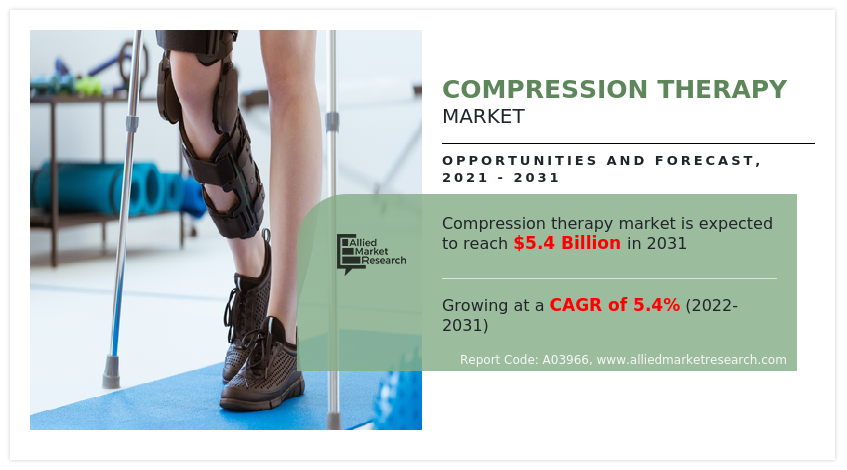
Historical overview
The compression therapy market has been analyzed qualitatively and quantitatively from 2021 to 2031. The compression therapy market witnessed growth at a CAGR of around 5.4% from 2022 to 2031. Most of the growth during this period was from North America owing to the increase in adoption of compression therapy products, rise in incidences of sports injuries and trauma as well as well-established presence of domestic market players in the region.
Market dynamics
Growth & innovations in the medical devices industry for the adoption of compression therapy devices for the treatment procedures of the diseases are driven by the massive pool of chronic diseases related to the veins such as deep vein thrombosis and varicose veins. The rise in number of patients of various diseases creates an opportunity for the Compression Therapy Industry. Moreover, a rise in the number of strategies adopted by the market players such as product launch, product approval, agreements, partnerships, and collaborations across the globe, is projected to affect market growth positively. For instance, in May 2020, AIROS Medical, Inc. announced the launch of Arm Plus apparel and has FDA 510(k) clearance. It has been used to treat the arm, shoulder, chest, and back lymphedema.
The demand for compression therapy is not only limited to developed countries but is also being witnessed in the developing countries, such as China, Brazil, and India, which fuel the growth of the market. Factors such as rise in the number treatment procedures performed and increase in awareness toward benefits of compression therapy for detection of the diseases further drive the growth of the market. Furthermore, rise in awareness related to advanced devices options boosts the adoption of compression therapy. In addition, an increase in research activities by manufacturers for developing advanced devices in treatment procedures is expected to fuel their adoption in the near future. However, the availability of alternative treatment procedures is hampering the Compression Therapy Market Growth.
Segmental Overview
The compression therapy market is segmented on the basis of technology, application, distribution channel and region. On the basis of technology, the market is classified into static compression therapy and dynamic compression therapy. Static compression therapy is further classified as static garments and compression braces. Dynamic compression therapy is classified as dynamic garments and compression pumps. On the basis of application, the market is classified into varicose vein treatment, deep vein thrombosis treatment, lymphedema treatment, leg ulcer treatment, and other applications. On the basis of distribution channel, the market is classified into hospital pharmacies, retail pharmacies, e-commerce and others. Region wise, the market is studied across North America (the U.S., Canada, and Mexico), Europe (Germany, France, UK, Italy, Spain, and Rest of Europe), Asia-Pacific (Japan, China, Australia, India, South Korea and rest of Asia-Pacific), and LAMEA (Brazil, South Africa, Saudi Arabia, and rest of LAMEA).
On the basis of the technique, the market is classified into static compression therapy and dynamic compression therapy. Static compression therapy is further classified as static garments and compression braces. Dynamic compression therapy is classified as dynamic garments and compression pumps. The static compression therapy segment dominated the global Compression Therapy Market Share in 2021 and is expected to remain dominant throughout the forecast period, owing to increase in adoption of static compression therapy for treatment of the target diseases and rise in the demand for static compression therapy among the patient population. Moreover, rise in the geriatric population as they are more prone to the disease as are likely anticipated to boosts the demand for compression therapy.
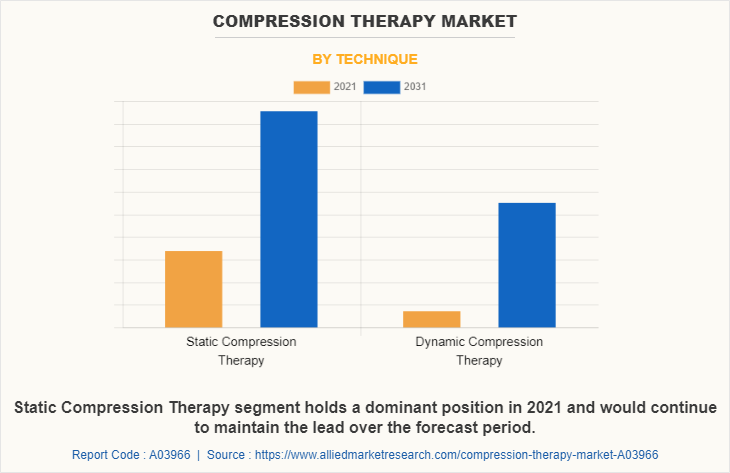
By application, the market is divided into varicose vein treatment, deep vein thrombosis treatment, lymphedema treatment, leg ulcer treatment, and other applications. The varicose vein treatment segment dominated the global Compression Therapy Market Size in 2021 and is anticipated to continue this trend during the forecast period. This is attributed to the increase in adoption of compression therapy in varicose veins. In addition, the devices used in treatment also are undergoing various developments which help boost the demand for the compression therapy device.
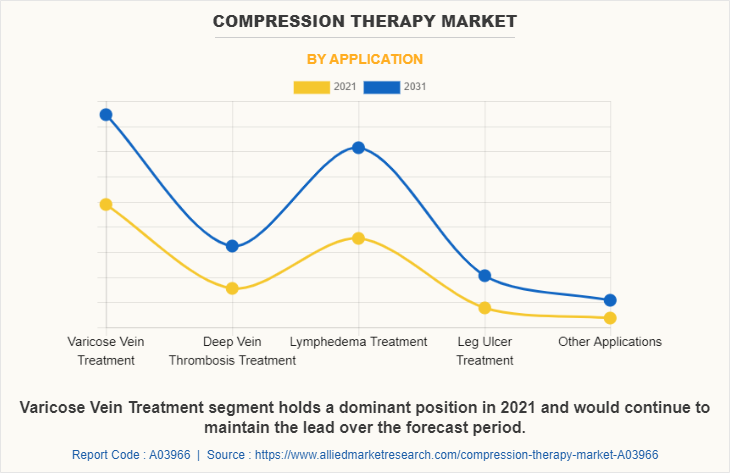
On the basis of the distribution channel, the market is classified into hospital pharmacies, retail pharmacies, E-commerce and others. The retail pharmacies segment dominated the global market in 2021 and is expected to remain dominant throughout the Compression Therapy Market Forecast period, owing to increase in sales of compression therapy products for treatment of the diseases through the E-Commerce platform and increase in the awareness of E-commerce platforms for the availability of the compression therapy products used commonly for the treatment.
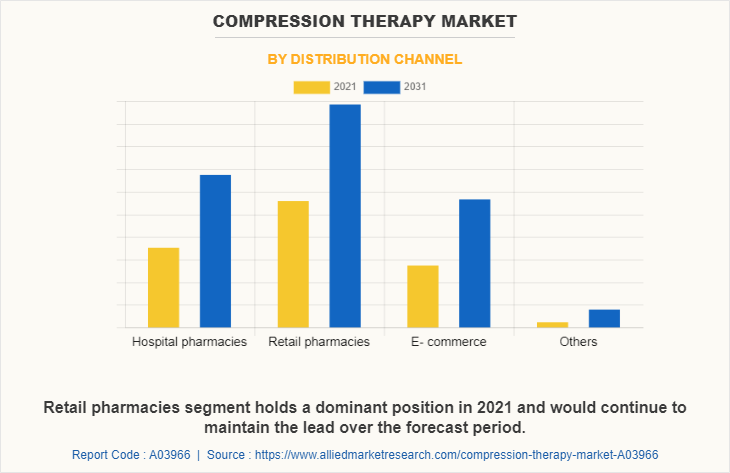
By region, the compression therapy market is analyzed across North America, Europe, Asia-Pacific, and LAMEA. In 2021, North America was the dominant region and is expected to remain the dominant region throughout the forecast period, owing to high prevalence rate of chronic disorders such as deep vein thrombosis and varicose veins, increase in number of market players and surge in number of devices available in the region. However, Asia-Pacific is expected to witness the highest CAGR during the analysis period, owing to the presence of high populace countries such as India and China, which in turn increases the number of chances of suffering from various types of chronic and fatal conditions, and the increasing number of strategies and trends adopted by the market players that include the product development, product approval, partnership, collaboration, and agreement.
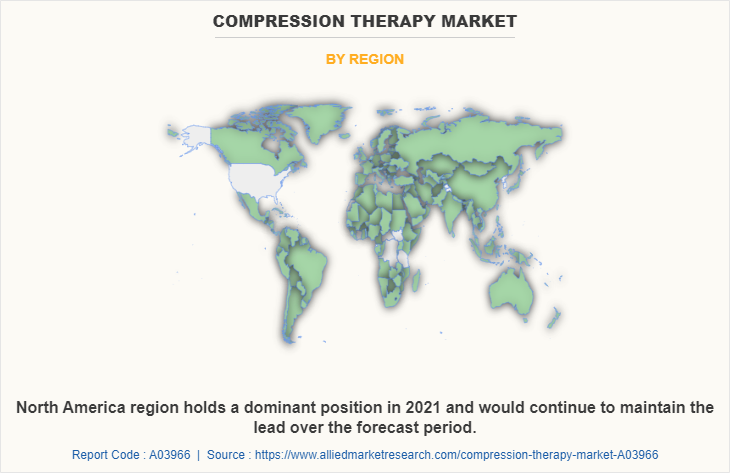
COMPETITION ANALYSIS
Competitive analysis and profiles of the major players in the compression therapy, such as 3M Company, Arjo, Bio Compression Systems, Inc., Cardinal Health Inc., Convatec Group PLC, Gottfried Medical Inc., Juzo, Sigvaris Group, Spectrum Healthcare, Tactile Medical are provided in this report. There are some important players in the market such as 3M Company, Cardinal Health Inc., Convatec Group PLC, Arjo and Bio Compression Systems, Inc. Various players have adopted product launch and product development as key developmental strategies to improve the product portfolio of the compression therapy market.
Product Approval in the market
In September 2021, Arjo announced that it has received 510(k) clearance from the US Food and Drug Administration (FDA) for WoundExpress, an intermittent pneumatic compression (IPC) solution for accelerating healing of venous leg ulcers. The FDA clearance follows several recent studies showing that WoundExpress can significantly improve lower leg wound management. Arjo’s WoundExpress is an Intermittent Pneumatic Compression (IPC) system to manage lower leg wounds with a garment applied on the patient’s thigh, uniquely placed away from the wound site to avoid painful pressure while increasing blood flow to the leg ulcer.
Product Launch in the market
In May 2020, AIROS Medical, Inc., a medical technology manufacturer specializing in compression therapy products that treat cancer-related lymphedema and venous complications, announced the launch of its updated AIROS 6 Sequential Compression Therapy device and Arm Plus garments following multiple regulatory approvals. AIROS earlier has received U.S. Food and Drug Administration (FDA) 510(k) clearance to market its updated AIROS 6 Sequential Compression Device and related accessory garments, including the Arm Plus garment that can be prescribed by a physician to treat lymphedema in the arm, shoulder, chest, and back.
Key Benefits For Stakeholders
- This report provides a quantitative analysis of the market segments, current trends, estimations, and dynamics of the compression therapy market analysis from 2021 to 2031 to identify the prevailing Compression Therapy Market Opportunity.
- The market research is offered along with information related to key drivers, restraints, and opportunities.
- Porter's five forces analysis highlights the potency of buyers and suppliers to enable stakeholders make profit-oriented business decisions and strengthen their supplier-buyer network.
- In-depth analysis of the compression therapy market segmentation assists to determine the prevailing market opportunities.
- Major countries in each region are mapped according to their revenue contribution to the global market.
- Market player positioning facilitates benchmarking and provides a clear understanding of the present position of the market players.
- The report includes the analysis of the regional as well as global compression therapy market trends, key players, market segments, application areas, and market growth strategies.
Compression Therapy Market Report Highlights
| Aspects | Details |
| Market Size By 2031 | USD 5.4 billion |
| Growth Rate | CAGR of 5.4% |
| Forecast period | 2021 - 2031 |
| Report Pages | 400 |
| By Distribution channel |
|
| By Technique |
|
| By Application |
|
| By Region |
|
| Key Market Players | 3M, Juzo, Tactile Medical, Arjo, Biocompression Systems, Convatec Group PLC, Gottfried Medical, Inc., Sigvaris Group, Spectrum Healthcare, Cardinal Health Inc. |
Analyst Review
In accordance with several interviews conducted, compression therapy involves wearing socks, stockings, or elastic garments intended to contain & support veins to increase blood circulation in legs. It is used for the treatment of leg swelling and discomfort and provides improved circulation for restoration of normal leg function. The compression stockings enable reduction of vein cavity and decreases venous pressure thereby preventing venous stasis and impairment of venous walks.
Asia-Pacific is expected to witness the highest CAGR during the analysis period, owing to the increase in the research and development expenditure for the development of the innovative and advanced products that increases the demand for the advanced compression therapy devices, increase in awareness about the compression therapy relates surgical procedures such as sclerotherapy and increase in government support for awareness of use of compression therapy products among the patients and other related trends adopted by the market players. However, alternative treatments and lack of awareness regarding compression therapies in population hamper the growth of the market.
The total market value of the Compression Therapy Market is $3,214.59 million in 2021.
The forecast period in the report is from 2022 to 2031
North America is the Largest Regional Market for Compression therapy Market
There are 10 Compression Therapy devices manufacturing companies are profiled in the report
The top companies that hold the market share in the 3M Company, Medtronic PLC, Bio Compression Systems, Inc., BSN Medical, Medi GmbH and Co. K, Paul Hartmann AG, Smith and Nephew PLC., Cardinal Health, Inc., Sigvaris, Sanyleg S.R.L.
The key trends in the Compression Therapy Market in are the Asia-Pacific region are increase in the prevalence of lymphedema and high population base.
The base year for the report is 2021.
The key trends in the Compression Therapy Market are the increasing prevalence of Deep Vein Thrombosis, the rising adoption of compression therapy, and a surge in technological advancement in dynamic compression therapy.
Loading Table Of Content...



